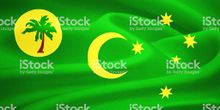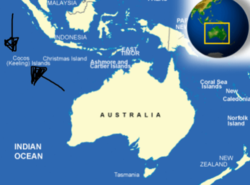Cocos (Keeling) Islands
Keeling Cocos The Territory of the Keeling Cocos Cocos (Keeling) Islands | |||
|---|---|---|---|
| |||
| Motto: Nobody's Ever Heard of Us | |||
| Capital | West | ||
| Largest city | Batman | ||
| Currency | 0.71 USD | ||
The Territory of the Keeling Cocos[1] is an archipelago of islands owned by Australia, located in the Indian Ocean. It is said to be where all coconuts come from, and is the birthplace of cocoa and cocaine. Cocos refers to the abundance of coconuts in the approximate vicinity, while Keeling comes from William Keeling, who was deemed to be unimportant in any capacity.
History[edit | edit source]
The islands were first created by the Ngarlam, an Aboriginal Australian people of the Pilbara region of Western Australia, which collectively decided to saw off a small piece of the continent and float it out to sea after being attacked repeatedly by populations of wild emus. Initial success was often hampered by invasions from the Spanish, overpopulation, and a rare disease known as no-water-itis[2]. This combination of factors would prompt much of the original piece of Western Australia to fracture sink below the waves in a cataclysmic event known as the Surfies Pash. All this would change with the invention of the coconut sometime in the early 16th century, which would change the island's social dynamic in the region. The archipelago would continue its monopoly on coconuts until the advent of capitalism, at which point the native Ngarlam people were said to have mysteriously vanished.
William Keeling would keelhaul[3] himself into frame sometime around the early 1600s, in which period he would vaguely look around, shrug his shoulders, and continue westward until dying of dropsy somewhere in the Indian ocean.
The only other person ever to do anything of remote importance on the island was noted Welshman and coconut aficionado John Clunies-Ross in 1853, which would claim the lands for the Netherlands in the name of King William III, naming it New Holland. After King William III's check bounced, however, he would go on to attempt to pawn off the island to the Colony of Western Australia. John Clunies-Ross would go on to live as the undisputed dictator of the island and its sole inhabitant until his death in 1854, at which point ownership defaulted to a raffle as held by the government of West Australia. To this day, Dutch-Australian relations have not recovered.[4]
Government[edit | edit source]
The capital of the islands is Palau, while the largest settlement is the village of Batman, which is noted as being ten meters under water.[5] People as born in this godforsaken place are noted as being granted at least sixteen different citizenships due to the intricate web of geopolitical territorial waters the nation is located in, the most notable of these being Australian, Malay, Indonesian, Papua New Guinean, New Zealand, and Spanish.
Economy[edit | edit source]
As the archipelago is only occasionally populated by small settlements of Lovecraftian fish men, it has no need for the traditional understanding of an economy. However, the islands are noted as being the largest exporter of coconuts in the world, accounting for nearly 28% of the global supply. Other notable exports include cocoa, the prime ingredient in chocolate, and cocaine, the prime ingredient of the 1980s.
References[edit | edit source]
Footnotes[edit | edit source]
- ↑ Not to be confused with its cooler brother, Christmas Island.
- ↑ This is notable as the Keeling Cocos Territory is surrounded on all sides by water, meaning that someone seriously fucked up at some point.
- ↑ As in hauling Keeling, not as in hauling under the keel of the vessel. A common mistake.
- ↑ This is cited as one of the principal factors behind Australia's entry into the Second World War.
- ↑ Not by choice, but rather by the weight of the coconuts stacked on top of the island. However, it has become a major spot for reef fishing.

